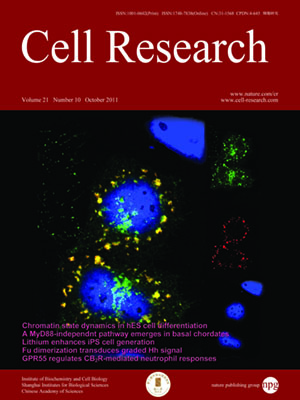
Volume 21, No 10, Oct 2011
ISSN: 1001-0602
EISSN: 1748-7838 2018
impact factor 17.848*
(Clarivate Analytics, 2019)
Volume 21 Issue 10, October 2011: 1393-1409
ORIGINAL ARTICLES
Dynamic chromatin states in human ES cells reveal potential regulatory sequences and genes involved in pluripotency
R David Hawkins1,*, Gary C Hon1,*, Chuhu Yang2, Jessica E Antosiewicz-Bourget3, Leonard K Lee1, Que-Minh Ngo1, Sarit Klugman1, Keith A Ching1, Lee E Edsall1
1Department of Cellular and Molecular Medicine, Ludwig Institute for Cancer Research,University of California, San Diego School of Medicine, La Jolla, CA 92093-0653, USA
2Morgridge Institute for Research, Madison, WI 53707, USA
3Genome Center of Wisconsin, University of Wisconsin, Madison, WI 53706, USA
4Roche NimbleGen, Madison, WI 53719, USA
5National Institutes of Allergy and Infectious Disease, Rockville, MD 20852, USA
Correspondence: James A Thomson, Bing Ren,(thomson@primate.wisc.edu; biren@ucsd.edu)
Pluripotency, the ability of a cell to differentiate and give rise to all embryonic lineages, defines a small number of mammalian cell types such as embryonic stem (ES) cells. While it has been generally held that pluripotency is the product of a transcriptional regulatory network that activates and maintains the expression of key stem cell genes, accumulating evidence is pointing to a critical role for epigenetic processes in establishing and safeguarding the pluripotency of ES cells, as well as maintaining the identity of differentiated cell types. In order to better understand the role of epigenetic mechanisms in pluripotency, we have examined the dynamics of chromatin modifications genome-wide in human ES cells (hESCs) undergoing differentiation into a mesendodermal lineage. We found that chromatin modifications at promoters remain largely invariant during differentiation, except at a small number of promoters where a dynamic switch between acetylation and methylation at H3K27 marks the transition between activation and silencing of gene expression, suggesting a hierarchy in cell fate commitment over most differentially expressed genes. We also mapped over 50 000 potential enhancers, and observed much greater dynamics in chromatin modifications, especially H3K4me1 and H3K27ac, which correlate with expression of their potential target genes. Further analysis of these enhancers revealed potentially key transcriptional regulators of pluripotency and a chromatin signature indicative of a poised state that may confer developmental competence in hESCs. Our results provide new evidence supporting the role of chromatin modifications in defining enhancers and pluripotency.
Cell Research (2011) 21:1393-1409. doi:10.1038/cr.2011.146; published online 30 August 2011
FULL TEXT | PDF
Browse 2056


